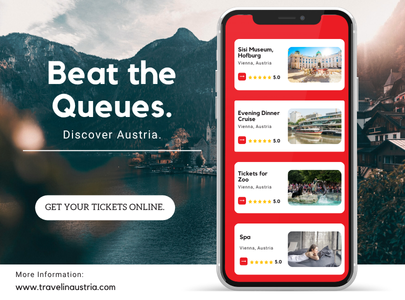One of the best ways to truly experience Vienna’s unique charm is to hop on its public transport. In this article, we’ll do our best to make using public transportation in Vienna as simple as possible for you!
You can navigate through the article by clicking on the desired link in the table of contents:
- 1. The Public Transportation System – General Information
- Subways
- Trams
- Buses
- Fast Trains
- Downloadable Map of Stations with Important Attractions – Recommended!
- 2. Accessibility
- 3. Buying Tickets – How? Where? And How Much?
- 4. Vienna Airport to City Center and Back – How to Get There Easily and Affordably?
- Regional Train S7
- CAT Express Train
- Vienna Airport Lines Bus
- Taxis
- 5. Useful Apps for Navigation and Travel in the City
- Quando
- Scotty
- Google Maps
- Uber
- Bolt
- 6. Alternative Transportation
- Horse-Drawn Carriages
- Tourist Bus (Hop On Hop Off)
- Bicycles
- Electric Scooters
- 7. How to Travel Outside Vienna?
Important Note for Families: Children Travel Free on Vienna’s Public Transportation in These Cases:
- Children under 6 years old don’t need a ticket and travel for free.
- Children aged 6-15 can travel for free and without limits on Austrian public holidays and during school breaks.
- During the rest of the year, there’s a discount on single journey tickets for this age group, but not for other ticket types.
1. The Public Transportation System – General Information
Vienna boasts four types of public transport that work together seamlessly, reaching every corner of the city (and beyond) quickly, efficiently, and frequently. Public transportation operates every day of the week. At night, there are night lines from 12:30 AM to 5:00 AM, and on weekends (Friday night and Saturday night), the subway runs continuously throughout the night.
Your city travel ticket covers all modes of transport within the city, so you can easily switch between the subway, tram, and bus without needing a new ticket or paying extra. Just keep in mind that Vienna Airport and the SCS shopping mall (where Primark is located) are outside the city limits, so the standard city ticket isn’t enough for those journeys.
In this section, we’ll detail the four types of transportation in Vienna:
Subways (U-Bahn)
There are five interconnected lines covering most of the city. In fact, it’s the primary mode of transport for getting around Vienna. The subway operates every day of the week. On weekdays, trains run from 5:00 AM until midnight. On Friday and Saturday nights, the subway runs non-stop until morning. On Sunday, the subway operates as usual.
Train frequency is very high – every 5 to 10 minutes on regular days (even every 2 minutes during peak hours). On weekends, it’s every 15 minutes, and at night, every 20 minutes.
Don’t worry if you miss a train; the next one will arrive quickly and precisely within a few minutes. Plus, there are clocks at every station showing the minutes until the next train arrives, along with its final destination.
Subway stations are wonderfully signposted with arrows and place names at every turn. Additionally, inside each train, you’ll find a general station map, the name of the upcoming station, and an announcement system that informs you about the next stop and connecting lines.

Subway lines include:
U1 – The Red Line.
This line connects the north of the city to its southern part. It passes through central stations in the First District like Schwedenplatz (where you’ll find the “Bermuda Triangle” of bars and restaurants, as well as the main synagogue and Jewish Square), Stephansplatz (home to the city’s main cathedral and the heart of the Old City), and Karlsplatz (where you’ll find St. Charles Church, the Opera House, the Albertina Museum, the Concert Hall, and more). The line also stops at Kagran station (near the large Donauzentrum mall), Praterstern station (where Prater Park is located), Hauptbahnhof (the central train station), and its final stop is the Vienna Spa at Oberlaa.
U2 – The Purple Line.
This line connects the east of the city to its center. It passes through several important stations such as Praterstern (where Prater Park is located), Taborstrasse (which is the Jewish street with kosher shops), Schottenring (with direct access to the Vienna Canal), Schottentor (next to the central university and Votive Church), Rathaus (where the impressive City Hall is), Volkstheater (near Hofburg Palace, City Garden, the Parliament building, and the large museum complex), and Museumsquartier (near the museum district and Mariahilfer Street, the main shopping street). The final stop of this line is Karlsplatz, near which you’ll find St. Charles Church, the Opera House, the Albertina Museum, the Concert Hall, and more.
U3 – The Orange Line.
This line connects the east of the city to its western part via the center. It passes through important stations like Westbahnhof (where Mariahilfer Street, the main shopping street, begins), Volkstheater (near Hofburg Palace, City Garden, the Parliament building, and the large museum complex), Stephansplatz (home to the city’s main cathedral and the heart of the Old City), Landstrasse (also called Wien Mitte, where the train from Vienna Airport stops), and Ergberg station (from where buses depart to nearby countries like the Czech Republic, Slovakia, Croatia, and more).
U4 – The Green Line.
This line connects the west of the city to its northern part. It passes through central stations such as Schottenring (with direct access to the Vienna Canal), Schwedenplatz (where you’ll find the “Bermuda Triangle” of bars and restaurants, as well as the main synagogue and Jewish Square), Landstrasse (also called Wien Mitte, where the train from Vienna Airport stops), Stadtpark (with the well-kept City Park), Karlsplatz (home to St. Charles Church, the Opera House, the Albertina Museum, the Concert Hall, and more), Kettenbrückengasse (where Naschmarkt, the famous market, is located), and Schönbrunn (where the magnificent palace and zoo are located).
U6 – The Brown Line.
This line connects the north of the city to its southern part. It’s considered less touristy as it doesn’t pass through the city center. There are two important stations where the line stops: Westbahnhof (where Mariahilfer Street, the main shopping street, begins) and Siebenhirten (from where there’s a shuttle to the SCS shopping city).
The U5 subway line is still under construction and will take at least 5-7 years to open. Link to download subway timetables.
Downloadable subway map with main attractions marked.
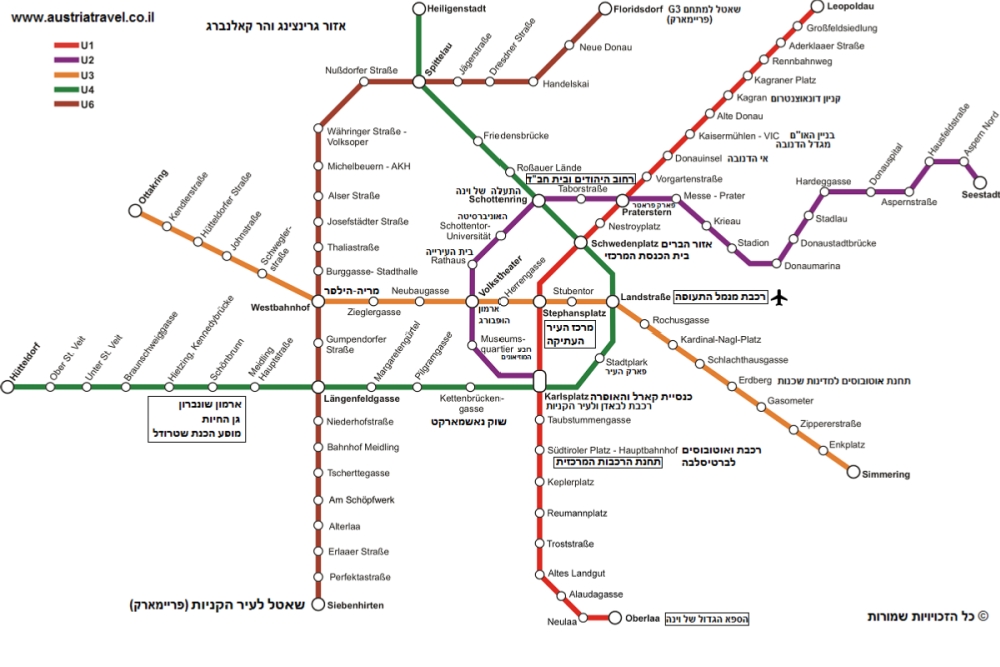
Trams (Strassenbahn)
To support the subway system, there’s an additional above-ground tram system with 29 lines and 500 trams. These trams reach into the heart of various neighborhoods, and sometimes you’ll need to combine a subway ride with a tram ride. Most trams are modern and air-conditioned, but some are still older and lack air conditioning (which can be uncomfortable in summer).
Trams operate from 5:00 AM until after midnight with a frequency of 5-20 minutes, depending on the area and time of day. At most stations, there’s an automatic clock showing the tram’s destination and the number of minutes until its arrival.
Link to download tram timetables.

Buses (Bus)
To make the transportation system even more efficient, there are 127 bus lines that reach almost every area of the city, even the most remote ones. Some buses are electric, and some are regular. Regular buses operate daily from 5:00 AM until after midnight with a frequency of 5-20 minutes depending on the area and time of day. From 12:30 AM to 5:00 AM, there are night lines marked with the letter N (N6, N92, etc.) that pass through all central locations and entertainment venues in the city. Night lines run every half hour and reach even the most distant neighborhoods of Vienna.
Link to download bus timetables.
Link to download night line timetables.
Fast Trains (Schnellbahn or S-Bahn)
These trains connect Vienna to nearby towns and villages. Within Vienna, you can use these trains to travel between stations just like the subway. You don’t need a separate ticket for the fast train if you’re staying within the city limits. The train to the airport, for example, is such a regional train, but since the airport is outside the city boundaries, you’ll need to pay an extra fare on top of the regular ticket price (don’t worry, we’ll explain this further in the article).
Fast trains operate from 4:00 AM until just before midnight.
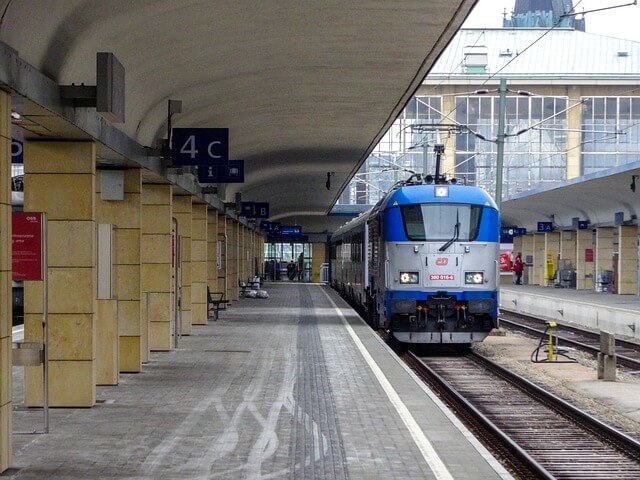
2. Accessibility
Vienna’s public transportation system is very accessible for people with disabilities. All subway stations are equipped with elevators that go directly to the platform. The trains themselves are at a comfortable height for wheelchair users, and this is also true for most trams and buses. All public transportation in Vienna has designated reserved spaces for people with disabilities, complete with special seat belts and ample room.
3. Buying Tickets – How? Where? And How Much?
Vienna’s travel tickets allow for seamless travel on all types of city transportation. With one ticket, you can switch from the subway to the tram, bus, fast train, and so on. You can change between modes of transport as much as you like; there are no separate tickets for each type of transport. This free travel is possible within the city limits (called the Kern Zone). Travel to Vienna Airport or the SCS shopping mall requires an additional payment as they are outside the city limits.
Good to know: Vienna’s transportation system is a beautiful example of a wonderful system based on trust and fairness (as much as possible). At the entrance to subway stations, for example, there are no barriers at all, so you can enter the train even without a ticket. But don’t be mistaken; traveling without a valid ticket is not advisable. Surprise checks are often conducted at station exits or by plainclothes inspectors. The fine for traveling without a valid ticket is quite hefty, and it’s a shame to part with €105 for a ticket that costs €2.40.
You can buy your travel ticket in several places:
- At subway stations: At the entrance to every station, there are automatic machines with touch screens for purchasing tickets. You can select English and order your tickets. After purchase, the ticket will be printed on the spot.
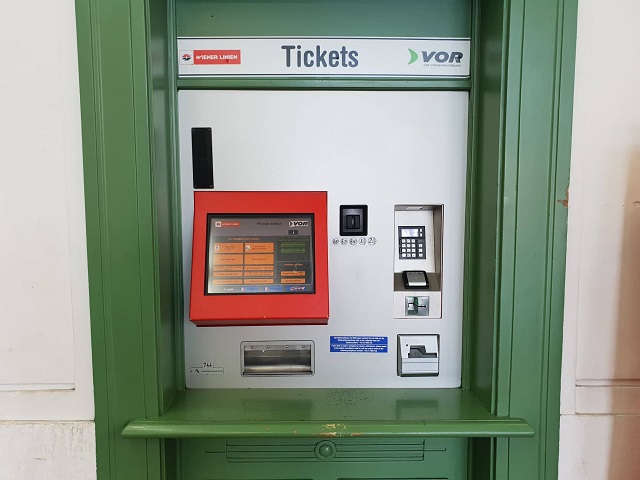
Please note! If you bought a ticket from a machine and it doesn’t show a validity period, the ticket you received is not valid until you validate it in the blue machines located before going down the stairs to the platform. Only after validating the ticket will it be valid for a one-way trip for 90 minutes. Validation machines are also found inside subways and buses, so the process is the same.
-
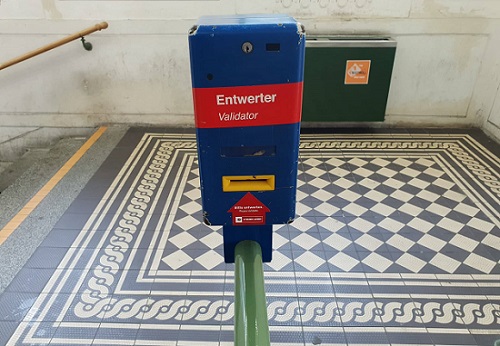
The device for validating travel tickets At Vienna’s central train stations: At major Vienna stations like Hauptbahnhof and Meidling, there are information and ticket purchase offices. You can also get additional information and guidance regarding purchasing multi-day tickets.
- Small convenience stores (called Tabak/Trafik): These types of stores are found almost everywhere and primarily sell drinks, newspapers, and magazines. You can purchase travel tickets from them if needed. These stores also sell, for example, an 8-journey ticket at a discounted price, which can be useful if you don’t want to buy an unlimited ticket for several consecutive days.
- On trams: You can purchase tickets inside the tram. There’s an automatic machine that only accepts coins. The price of tickets bought inside the tram is 20 cents higher than the regular price.
- Recommended! The WienMobil app: The official app of Vienna’s transport company allows you to purchase tickets online. This is probably the most convenient solution for your trip.
The prices of travel tickets vary depending on the ticket type:
1. Single Journey Ticket
€2.40 for an adult (from age 15). The ticket is valid from the moment it’s validated for a continuous one-way journey (you cannot use the same ticket for a round trip or to stop midway for coffee and then continue your journey with the same ticket).
2. 24-Hour Ticket
€8.00 for an adult (from age 15). This ticket allows unlimited travel on all types of public transport in the city for 24 hours from the date indicated on it (if purchased online). If you buy this ticket at a station machine, you need to validate it before your first journey, and then it’s valid for 24 hours from the time of validation. You can order the ticket in advance and print it at home (or show it on your phone) (for online purchase) or buy it at train stations or automatic vending machines. The ticket is non-transferable.
3. 48-Hour Ticket
€14.10 for an adult (from age 15). This ticket allows unlimited travel on all types of public transport in the city for 48 hours from the date indicated on it (if purchased online). If you buy this ticket at a station machine, you need to validate it before your first journey, and then it’s valid for 48 hours from the time of validation. You can order the ticket in advance and print it at home (or show it on your phone) (for online purchase) or buy it at train stations or automatic vending machines. The ticket is non-transferable.
4. 72-Hour Ticket
€17.10 for an adult (from age 15). This ticket allows unlimited travel on all types of public transport in the city for 72 hours from the date indicated on it (if purchased online). If you buy this ticket at a station machine, you need to validate it before your first journey, and then it’s valid for 72 hours from the time of validation. You can order the ticket in advance and print it at home (or show it on your phone) (for online purchase) or buy it at train stations or automatic vending machines. The ticket is non-transferable.
5. Flexible Weekly Ticket
Physical Ticket: As of July 1, 2024, you can also buy a weekly ticket at the machines at subway station entrances. A paper ticket from the machine is transferable (it’s not registered to a specific name) and you can decide the start date of its validity. From the moment it’s validated, you can travel unlimited on all public transport in the city for 7 days. The cost of this ticket is €22.60.
Digital Ticket: The digital ticket must be purchased online through the official website of Vienna’s transport company or via the WienMobil app. After purchase, a QR code will appear, which serves as your ticket. You’ll need to show this code to an inspector if there’s a ticket check. This ticket is non-transferable. The cost of the digital ticket is €19.70.
6. Monthly Ticket
Physical Ticket: As of July 1, 2024, you can purchase a flexible 31-day travel ticket at subway station machines. The ticket is transferable, and its validity begins from the moment it’s validated in the machine, lasting for 31 days. As long as the ticket is valid, you can travel unlimited on all means of transport in Vienna. The cost of the ticket for an adult (from age 15) is €58.70.
Digital Ticket: This ticket allows unlimited travel on all types of public transport in the city for 31 days starting from a date of your choice. You can order the ticket in advance and show it on your phone (for online purchase). This ticket is non-transferable. The cost of the digital ticket is €51.00.
7. Vienna Card
This card offers free public transport for 24/48/72 hours. The added bonus is that it also provides discounts at 210 locations across the city. Plus, a child up to 15 years old can join an adult holding this card for free. You can purchase the card online.
4. Vienna Airport to City Center and Back – How to Get There Easily and Affordably?
Vienna Airport (Flughafen Wien) is about a 20-minute drive from Vienna’s city center. You can easily and affordably get to or from the airport using public transportation (trains like S7 or REX, as well as direct buses to the city). The airport is not included within Vienna’s city limits, so even if you’ve purchased a weekly public transport ticket for Vienna, you’ll need to add about €2.00 for the train journey from the airport to the city boundary. If you choose to take the train into the city, you can purchase a ticket through the ÖBB app, at the ÖBB counter in the arrivals hall, or at the machines before descending to the platform.
There are several recommended ways to get from the airport to the city and back. You can read more about the various transportation options in our dedicated article on public transportation from Vienna Airport.
Please note: In the late-night hours, there is no public transportation from Vienna Airport to the city center. You’ll need to book a taxi, Bolt, Uber, or any private transfer service. Interested in an offer for a private transfer from the airport? Click to arrange an airport transfer.
5. Useful Apps for Navigation and Travel in the City
When it comes to navigating Vienna easily, you’ll find plenty of great apps. These apps will show you exactly which lines to take, when to get off, and when each line will arrive. All you need to do is open the app, allow location tracking, and enter your starting point and destination.
Other apps will simply help you avoid public transportation affordably and quickly.
Here are 5 recommended apps we’ve gathered for you:
- Qando – This was the first app to completely map public transportation and make city navigation incredibly simple. The app is convenient and easy to use. You can download it to your phone or view the times online.
- [View timetables online].
- [Download for Android].
- [Download for iPhone].
- Scotty – Qando’s local competitor. This is an online service offered by the Austrian railway company. It allows for flexible and convenient travel planning both within and outside the city. [To the official website].
- Google Maps – About two years ago, Google began offering public transportation timetables for Vienna as part of its Maps app. Today, it’s the most convenient app for navigating the city because it also integrates the city’s main attractions. With the app, you can see the fastest route from one place to another, the timetables of the lines, and the travel route. Convenient, simple, and efficient.
- Uber – If you’re not keen on navigating public transportation, you can use Uber’s driver service. Through their app, you can order a driver from anywhere in the city at a known price in advance and pay everything through the app. Please note that you need to link your PayPal account or credit card to use the app. There’s no direct payment to the driver.
- Bolt – Uber’s biggest competitor in Vienna is the app recently launched in the city called Bolt. Through their app, you can order a driver from anywhere in the city at a known price in advance and pay everything through the app. Please note that you need to link your PayPal account or credit card to use the app. There’s no direct payment to the driver. Bolt’s prices are slightly cheaper than Uber’s.
6. Alternative Transportation
There are other ways to get around Vienna. We’ve gathered four delightful methods here, some of which even locals enjoy using for getting around.
- Horse-Drawn Carriages A true tourist attraction! You can ride through the Old City in an antique carriage pulled by horses. It’s a unique experience that beautifully complements the romantic atmosphere of the city. You can read more about horse-drawn carriage tours in Vienna in our extended article.
- Tourist Bus (Hop On Hop Off) This bus is the quickest and simplest way to see the city’s most important sights. It’s especially suitable for cold and rainy days or for travelers visiting Vienna for a short time. The bus route passes by most of Vienna’s must-see attractions. You can hop on and off along the route and take in the best of the city. [For more information and to purchase tickets for the tourist bus].
- Bicycles (WienMobil Rad) Vienna has plenty of well-maintained and safe bike paths. You can cycle in the large parks, along the canal, or on Danube Island. On a warm, sunny day, it can be a truly wonderful experience. There are many city bike rental stations scattered throughout the city. While these bikes are primarily intended for residents, visitors can also enjoy them even if they’re only in the city for a short time. To rent a bike, you need to download the WienMobil Rad app and register. Payment is based on bike usage. [More information and a link to download the app].
- Electric Scooters Vienna has many electric scooter rental companies. Almost anywhere in the city, you’ll find scooters available for rent based on ride time. The scooters are new and advanced, and you can rent them through the apps of various companies. Companies operating in Vienna include: Lime, Link, Bird, Tier.
7. How to Travel Outside Vienna?
Around Vienna, you’ll find wonderful nature, authentic Austrian villages, and interesting historical sites. It’s definitely worth leaving the city for at least one day to experience rural Austria. If you’ve decided you don’t want to rent a car in Vienna and travel independently outside the city, you can use public transport or join a [day tour from Vienna in Hebrew] which will make planning and lugging around on public transport much easier.
Intercity trains depart frequently from Vienna to all parts of the country. You can take a train to Salzburg, the Wachau Valley, Baden, or to the natural areas in the east or south of the country. You can use the ÖBB app from the Austrian railway company to book tickets or book tickets directly at Vienna’s central train stations (Hauptbahnhof, Westbahnhof).
If you haven’t completed your trip preparations for Vienna yet, consider checking out our [comprehensive guide to planning your trip] in the city or simply use our [ready-made itinerary for 3 or 4 days in Vienna].










